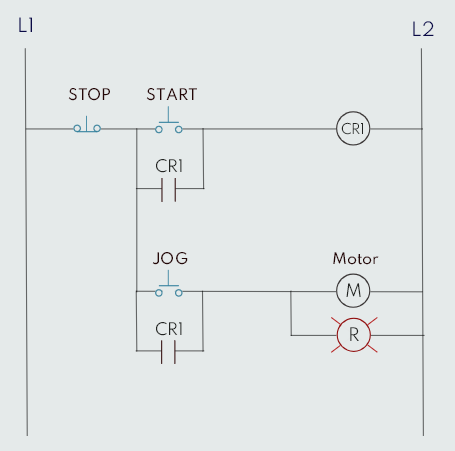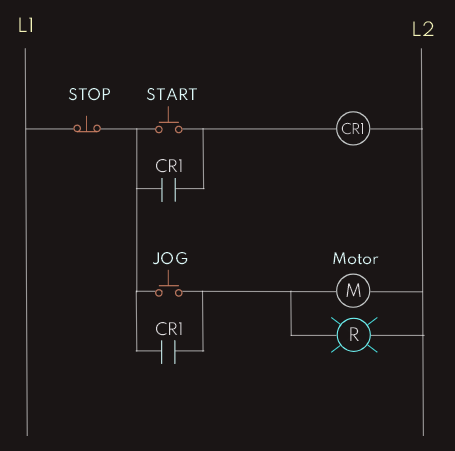



RLD for Industrial Control Circuits
Drawing a relay logic diagram of an industrial control system requires two steps:
1. clearly define the control problem (i.e. drawing a schematic diagram and discussing the problem with production and maintenance engineers and technicians)
2. review and follow the nine relay logic diagram rules mentioned previously to draw the relay logic diagram
Example:
Let's draw the RLD for the following motor control problem.
Solution:
Step 1 / Define the problem: A motor can operate in continuous run mode or in temporary run mode, also called jog mode. Therefore, in a motor control system we need one stop pushbutton and two run pushbuttons. One of the run pushbuttons is for continuous run mode operation, and the other is for temporary run mode operation. The pushbutton for the continuous run mode operation is labeled START, and the pushbutton for the temporary run mode operation is labeled JOG. If we press the JOG pushbutton, the motor will run as long as we are pressing the pushbutton, which is equivalent to closing a normally open switch. If we press the START pushbutton, the motor will start running continuously until we press the STOP pushbutton. The red pilot light is ON whenever the motor is operating.
Step 2 / Draw the relay logic diagram: Figure on the right displays the relay logic diagram for the motor control system. The STOP pushbutton is normally closed pushbutton. When the normally open START pushbutton is closed, the relay coil CR1 energizes. The normally open contact CR1 closes and seals or locks the relay coil. Therefore, the relay coil is energized as long as the normally closed STOP pushbutton is closed. The normally open contact CR1 closes and turns the motor and red pilot light ON.
This is continuous run mode operation.
With the motor OFF, pressing the normally open JOG pushbutton turns on the motor and the red pilot light. Whenever the JOG pushbutton is released, the motor and the red pilot light turn OFF.
This is jog or temporary run mode operation.


Analog vs. Digital
Analog basically means a continuously variable signal. It means that the item being measured can be chopped up into infinite little pieces over time. Say, for example, a signal changes from A to B over a 1-second interval. If we look at it before 1 second is over it will be somewhere between A and B. It is a continuous variable. No matter how small you slice up the time segments, there is still a signal with information there.
The world as we perceive it is analog in nature. Colors, for example, blend infinitely from one end of the spectrum into the other. As we drive a car, we continuously change speed in response to the traffic and environment around us. The world around us is analog.
So what, then, is digital?
Let's hold up one of the digits on our hand. Now we put it down, now we put it up again. This is digital. It is either there, or it is not. So the simplest form of digital is two states: It’s either there or not.
But further, what about the time it takes to change state? What if we look at our digital finger as it moves from all the way down to all the way up? If we look at it carefully, we see that a digital signal is really analog in nature. So digital is really just a mode of perception. You look at something in a specifically determined time frame and define whether it is there or it is not. Digital is a predetermined definition of analog levels.
Early on it was discovered that digital signals worked well in communication. What is the drawback to using digital signals? The telegraph (used a digital dot/dash series to represent a letter) for example didn’t last long. It was quickly replaced by analog forms of communication. The reason for this has to do with bandwidth, a measure of the amount of information a signal can carry. The analog signal can carry vast amounts of information. It can have an infinite number of levels for a given signal range.
Analog signals can represent large amounts of information much more easily than digital signals can. To do this, though, we just need more power. Without more power, noise or other unwanted information can easily disrupt the signal. This is what happens when we get too far away from our favorite radio station and it starts to sound fuzzy.
On the other hand, to get a digital signal to move a lot of information, it has to work fast. Back when people wanted to hear each other talk, it was much easier to use analog signals. The digital technology of the time simply couldn’t work fast enough to represent all the complexities of the audio information. Thus for many years communication efforts focused on analog encoding and decoding of information. However, digital was being used in another domain entirely, in the application of Boolean logic. Boolean logic is based on a digital representation of the world.
The upsides of analog are that it can represent lots of information, and the world around us can easily be represented by analog signals. The downsides are that it takes more power in either the transmitter or receiver to resolve the analog signals, and small analog signals can be easily disrupted by outside influences.
The upsides of digital are low power transmission and the ability to represent logic statements. The downsides are information limits (low bandwidth), requiring it to work fast to process large pieces of information, and the fact that the world around us is analog, not digital in nature.
Analog to Digital is all about taking the real world and making it into ones and zeros so that digital technology can manipulate it. We can reasonably say that Digital to Analog reverses the process.
An analog signal is converted to digital by chopping it up into chunks at predetermined time intervals. This chopping is called the sample rate. The faster the sample rate, the higher the frequency that can be digitized. Then the signal is measured at that point in time and assigned a digital value, which is called sampling the signal. Digital signals is typically represented as 1 or 0. Now that we have digital signal, we can transmit it, receive it, and manipulate it without worrying much about signal loss. Let's say we convert guitar music into digital format to add some neat sound effects. We can’t simply send the digital data back out to be heard. It must be converted back to analog. Why? Because there are certain things we perceive well in an analog format. To convert a digital signal back to analog, the circuit has to simulate the analog signal it represents. This always requires some kind of filtering. There are many ways to convert digital to analog.
DSP, or digital signal processing, refers to manipulating data that is digitized from an analog signal. In many cases, such as audio and video, the signal is converted back to analog after DSP occurs. One of the advantages of a DSP is the ability to change parameters of the filters on the fly. This allows engineers to create all sorts of new solutions to processing signals that are very difficult to achieve with comparable analog designs. Without DSP, we wouldn’t have MP3, WMA, AC3, AAC, MP4, WiFi, and many more acronyms that are not mentioned here.









